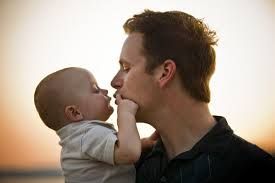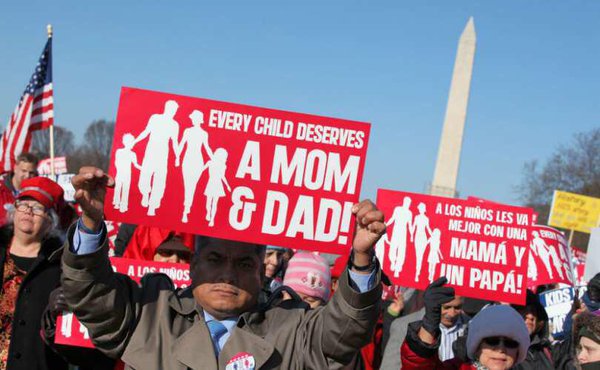THE FATHER FACTOR
Data on the Consequences of Father Absence ~
According to the U.S. Census Bureau, 24 million children in America -- one out of three -- live in biological father-absent homes. Consequently, there is a "father factor" in nearly all of the social issues facing America today. Scroll down to view data on the effects of father absence on: poverty, maternal and child health, incarceration, crime, teen pregnancy, child abuse, drug and alcohol abuse, education, and childhood obesity.
Father Factor in Poverty ~Children in father-absent homes are almost four times more likely to be poor. In 2011, 12 percent of children in married-couple families were living in poverty, compared to 44 percent of children in mother-only families.
U.S.
Census Bureau, Children’s Living Arrangements and Characteristics: March 2011,
Table C8. Washington D.C.
Click here to access additional, free research on father absence and poverty
Father Factor in Emotional and Behavioral Problems ~Data from three waves of the Fragile Families Study (N= 2,111) was used to examine the prevalence and effects of mothers’ relationship changes between birth and age 3 on their children’s well being. Children born to single mothers show higher levels of aggressive behavior than children born to married mothers. Living in a single-mother household is equivalent to experiencing 5.25 partnership transitions.
Source: Osborne, C., & McLanahan, S. (2007). Partnership
instability and child well-being. Journal of Marriage and Family, 69, 1065-1083
A sample of 4,027 resident fathers and children from the
Fragile Families and Child Well-Being Survey was used to investigate the
effects of a biological father’s multipartner fertility (having at least one
child with more than one mother) on adolescent health. Resident fathers
engaging in multipartner fertility were older, more likely to be White, and had
lower education levels and income, compared to fathers with one partner.
Results indicated children’s externalizing behaviors were negatively affected
directly and indirectly when their biological father had children with multiple
partners. Source: Bronte-Tinkew, J., Horowitz, A., & Scott, M. E.
(2009). Fathering with multiple partners: Links to children’s well-being in
early childhood. Journal of Marriage and Family, 71, 608–631.
Father Factor in Maternal and Child Health ~ Infant mortality rates are 1.8 times higher for infants of unmarried mothers than for married mothers.
Source: Matthews, T.J., Sally C. Curtin, and Marian F.
MacDorman. Infant Mortality Statistics from the 1998 Period Linked Birth/Infant
Death Data Set. National Vital Statistics Reports, Vol. 48, No. 12. Hyattsville , MD : National Center

Father Factor in Incarceration ~
Even after controlling for income, youths in father-absent
households still had significantly higher odds of incarceration than those in
mother-father families. Youths who never had a father in the household
experienced the highest odds.
Source: Harper, Cynthia C. and Sara S. McLanahan. “Father
Absence and Youth Incarceration.” Journal of Research on Adolescence 14
(September 2004): 369-397. A 2002 Department of Justice survey of 7,000 inmates
revealed that 39% of jail inmates lived in mother-only households. Approximately
forty-six percent of jail inmates in 2002 had a previously incarcerated family
member. One-fifth experienced a father in prison or jail. Source: James, Doris J. Profile of Jail Inmates, 2002.
(NCJ 201932). Bureau of Justice Statistics Special Report, Department of
Justice, Office of Justice Programs, July 2004. Click here to access additional, free research on father absence and incarceration
Father Factor in Crime ~ A study of 109 juvenile offenders indicated that family structure significantly predicts delinquency.
Source: Bush, Connee, Ronald L. Mullis, and Ann K. Mullis.
“Differences in Empathy Between Offender and Nonoffender Youth.” Journal of
Youth and Adolescence 29 (August 2000): 467-478. A study of low-income minority adolescents aged 10-14 years
found that higher social encounters and frequent communication with nonresident
biological fathers decreased adolescent delinquency. Source: Coley, R. L., & Medeiros, B. L. (2007).
Reciprocal longitudinal relations between nonresident father involvement and
adolescent delinquency. Child Development, 78, 132–147. Click here to access additional, free research on father absence and crime
Father Factor in Teen Pregnancy & Sexual Activity ~
 Being raised by a single mother raises the risk of teen
pregnancy, marrying with less than a high school degree, and forming a marriage
where both partners have less than a high school degree. Source: Teachman, Jay D. “The Childhood Living Arrangements
of Children and the Characteristics of Their Marriages.” Journal of Family
Issues 25 (January 2004): 86-111. Separation or frequent changes increase a woman’s risk of
early menarche, sexual activity and pregnancy. Women whose parents separated
between birth and six years old experienced twice the risk of early
menstruation, more than four times the risk of early sexual intercourse, and
two and a half times higher risk of early pregnancy when compared to women in
intact families. The longer a woman lived with both parents, the lower her risk
of early reproductive development. Women who experienced three or more changes
in her family environment exhibited similar risks but were five times more
likely to have an early pregnancy. Source: Quinlan, Robert J. “Father absence, parental care,
and female reproductive development.” Evolution and Human Behavior 24 (November
2003): 376-390. Click here to access additional, free research on father absence and teen pregnancy.
Being raised by a single mother raises the risk of teen
pregnancy, marrying with less than a high school degree, and forming a marriage
where both partners have less than a high school degree. Source: Teachman, Jay D. “The Childhood Living Arrangements
of Children and the Characteristics of Their Marriages.” Journal of Family
Issues 25 (January 2004): 86-111. Separation or frequent changes increase a woman’s risk of
early menarche, sexual activity and pregnancy. Women whose parents separated
between birth and six years old experienced twice the risk of early
menstruation, more than four times the risk of early sexual intercourse, and
two and a half times higher risk of early pregnancy when compared to women in
intact families. The longer a woman lived with both parents, the lower her risk
of early reproductive development. Women who experienced three or more changes
in her family environment exhibited similar risks but were five times more
likely to have an early pregnancy. Source: Quinlan, Robert J. “Father absence, parental care,
and female reproductive development.” Evolution and Human Behavior 24 (November
2003): 376-390. Click here to access additional, free research on father absence and teen pregnancy.Father Factor in Child Abuse ~
 A study using data from the Fragile Families and Child
Wellbeing Study revealed that in many cases the absence of a biological father
contributes to increased risk of child maltreatment. The results suggest that
Child Protective Services (CPS) agencies have some justification in viewing the
presence of a social father as increasing children’s risk of abuse and neglect.
It is believed that in families with a non-biological (social) father figure,
there is a higher risk of abuse and neglect to children, despite the social
father living in the household or only dating the mother. Source: “CPS Involvement in Families with Social Fathers.”
Fragile Families Research Brief No.46.
A study using data from the Fragile Families and Child
Wellbeing Study revealed that in many cases the absence of a biological father
contributes to increased risk of child maltreatment. The results suggest that
Child Protective Services (CPS) agencies have some justification in viewing the
presence of a social father as increasing children’s risk of abuse and neglect.
It is believed that in families with a non-biological (social) father figure,
there is a higher risk of abuse and neglect to children, despite the social
father living in the household or only dating the mother. Source: “CPS Involvement in Families with Social Fathers.”
Fragile Families Research Brief No.46.  Source: Guterman, N.B., Yookyong, L., Lee, S. J., Waldfogel,
J., & Rathouz, P. J. (2009). Fathers and maternal risk for physical child
abuse. Child Maltreatment, 14, 277-290. Click here to access additional, free research on father absence and child abuse and neglect.
Source: Guterman, N.B., Yookyong, L., Lee, S. J., Waldfogel,
J., & Rathouz, P. J. (2009). Fathers and maternal risk for physical child
abuse. Child Maltreatment, 14, 277-290. Click here to access additional, free research on father absence and child abuse and neglect. Father Factor in Drug and Alcohol Abuse ~

 Even after controlling for community context, there is
significantly more drug use among children who do not live with their mother
and father. Source: Hoffmann, John P. “The Community Context of Family
Structure and Adolescent Drug Use.” Journal of Marriage and Family 64 (May
2002): 314-330. In a study of 6,500 children from the ADDHEALTH database,
father closeness was negatively correlated with the number of a child’s friends
who smoke, drink, and smoke marijuana. Closeness was also correlated with a
child’s use of alcohol, cigarettes, and hard drugs and was connected to family
structure. Intact families ranked higher on father closeness than single-parent
families. Source: National Fatherhood Initiative. “Family Structure,
Father Closeness, & Drug Abuse.”
Even after controlling for community context, there is
significantly more drug use among children who do not live with their mother
and father. Source: Hoffmann, John P. “The Community Context of Family
Structure and Adolescent Drug Use.” Journal of Marriage and Family 64 (May
2002): 314-330. In a study of 6,500 children from the ADDHEALTH database,
father closeness was negatively correlated with the number of a child’s friends
who smoke, drink, and smoke marijuana. Closeness was also correlated with a
child’s use of alcohol, cigarettes, and hard drugs and was connected to family
structure. Intact families ranked higher on father closeness than single-parent
families. Source: National Fatherhood Initiative. “Family Structure,
Father Closeness, & Drug Abuse.” 
Father Factor in Childhood Obesity ~
 The National Longitudinal Survey of Youth found that obese
children are more likely to live in father-absent homes than are non-obese
children. Source: National Longitudinal Survey of Youth. In a study using a sample of 2,537 boys and 2,446 girls,
researchers investigated the relationship between Body Mass Index (BMI) status
at ages 4 to 5 years and mothers’ and fathers’ parenting involvement and
parenting styles. The results showed that only fathers’ parenting behaviors and
styles were associated with increased risks of child overweight and obesity.
Mothers’ parenting behaviors and styles were not associated with a higher
likelihood of children being in a higher BMI category. In the case of fathers,
however, higher father control scores were correlated with lower chances of the
child being in a higher BMI category. Moreover, children of fathers with
permissive and disengaged parenting styles had higher odds of being in a higher
BMI category. Source: Wake, M., Nicholson, J.M., Hardy, P., & Smith,
K. (2007). Preschooler obesity and parenting styles of mothers and fathers:
Australian national population study, Pediatrics, 12, 1520-1527. Click here to access additional, free research on father absence and childhood obesity.
The National Longitudinal Survey of Youth found that obese
children are more likely to live in father-absent homes than are non-obese
children. Source: National Longitudinal Survey of Youth. In a study using a sample of 2,537 boys and 2,446 girls,
researchers investigated the relationship between Body Mass Index (BMI) status
at ages 4 to 5 years and mothers’ and fathers’ parenting involvement and
parenting styles. The results showed that only fathers’ parenting behaviors and
styles were associated with increased risks of child overweight and obesity.
Mothers’ parenting behaviors and styles were not associated with a higher
likelihood of children being in a higher BMI category. In the case of fathers,
however, higher father control scores were correlated with lower chances of the
child being in a higher BMI category. Moreover, children of fathers with
permissive and disengaged parenting styles had higher odds of being in a higher
BMI category. Source: Wake, M., Nicholson, J.M., Hardy, P., & Smith,
K. (2007). Preschooler obesity and parenting styles of mothers and fathers:
Australian national population study, Pediatrics, 12, 1520-1527. Click here to access additional, free research on father absence and childhood obesity.
 Father Factor in Education ~
Father Factor in Education ~
Father involvement in schools is associated with the higher
likelihood of a student getting mostly A's. This was true for fathers in
biological parent families, for stepfathers, and for fathers heading
single-parent families.
Source: Nord, Christine Winquist, and Jerry West. Fathers’
and Mothers’ Involvement in Their Children’s Schools by Family Type and
Resident Status. (NCES 2001-032). Washington , D.C. : U.S.
Department of Education, National
Center

























 Do you support a presumption of equal parental fitness, regardless of gender, being enshrined in law in accordance with the 14th Amendment?
Do you support a presumption of equal parental fitness, regardless of gender, being enshrined in law in accordance with the 14th Amendment?















